
Welcome to the biweekly electronic newsletter from Stanford Bio-X for members of the Bio-X Corporate Forum. Please contact Dr. Hanwei Li, the Bio-X Corporate Forum Liaison if you would like to be added or removed from this distribution list, or if you have any questions about Stanford Bio-X or Stanford University.
Highlights
** On October 9, 2013, Bio-X celebrated the 10th Anniversary of the James H. Clark Center, the hub of Bio-X. Check out CLARK CENTER @ 10X as well as the Bio-X Timeline over the last 15 years!!
** Check out the article by Stanford President John Hennessy in the Nov/Dec 2013 issue of the Stanford Magazine on Bio-X and the Clark Center, "A Cauldron of Innovation".
Nobel Prize for Stanford chemist W.E. Moerner!!
 Congratulations to W.E. Moerner, the Harry S. Mosher Professor of Chemistry at Stanford, who was awarded the 2014 Nobel Prize in Chemistry for his work on microscopy techniques that allow scientists to visualize precise molecular mechanisms inside living cells. "The path-breaking work of Professor Moerner and his colleagues has made a major contribution to our ability to observe molecules at the smallest scales, opening up new possibilities for discovery in areas ranging from disease management to drug development," Stanford President John L. Hennessy said. "The Nobel Prize recognizes this remarkable work, of which all of us in the Stanford community are immensely proud."Click here to read the news on Prof. Moerner's award!
Congratulations to W.E. Moerner, the Harry S. Mosher Professor of Chemistry at Stanford, who was awarded the 2014 Nobel Prize in Chemistry for his work on microscopy techniques that allow scientists to visualize precise molecular mechanisms inside living cells. "The path-breaking work of Professor Moerner and his colleagues has made a major contribution to our ability to observe molecules at the smallest scales, opening up new possibilities for discovery in areas ranging from disease management to drug development," Stanford President John L. Hennessy said. "The Nobel Prize recognizes this remarkable work, of which all of us in the Stanford community are immensely proud."Click here to read the news on Prof. Moerner's award!
W.E. Moerner is also a Bio-X affiliated faculty member who has received 2 Bio-X IIP Seed Grant awards for: "Single-molecule probes of chaperone-assisted folding" in 2000 and "Single molecule and high-resolution imaging of developmental signal transducers" in 2012. He has a Bio-X Graduate Fellow, Lucien Weiss, whose work is titled "Intracellular transport and trafficking in hedgehog signal transduction".
Seed Grants
**UPDATE: BIO-X HAS JUST ANNOUNCED ITS 22 NEWLY AWARDED IIP SEED GRANT PROJECTS OF ROUND 7!! Click on the link to check out the project descriptions and read on to learn more about this round!
 SEED GRANTS FOR SUCCESS - Stanford Bio-X Interdisciplinary Initiatives Program (IIP)
SEED GRANTS FOR SUCCESS - Stanford Bio-X Interdisciplinary Initiatives Program (IIP)
The Bio-X Interdisciplinary Initiatives Program represents a key Stanford Initiative to address challenges in human health. The IIP awards approximately $3 million every other year in the form of two-year grants averaging about $150,000 each. From its inception in 2000 through the fifth round in 2010, the program has provided critical early-stage funding to 114 different interdisciplinary projects, involving collaborations from over 300 faculty members, and creating over 450 teams from five different Stanford schools. From just the first 5 rounds, the IIP awards have resulted in a 10-fold-plus return on investment, as well as hundreds of publications, dozens of patents filed, and most importantly, the acceleration of scientific discovery and innovation.
This year is the 7th round of the Bio-X IIP Seed Grants Program, and Bio-X has just announced it's 22 newly awarded projects selected from 142 Letters of Intent (LOIs)! This has been the largest number of LOIs that Bio-X has received. Please go here to check out the newly awarded projects. Competition was intense, and the selection criteria included innovation, high-reward, and new interdisciplinary collaborations. (To view the 142 other IIP projects that have been funded from the previous 6 rounds, please click here.)
We are cultivating and are highly successful in building meaningful collaborations with numerous corporate colleagues. New collaborations through our seed grant projects are highly encouraged. To learn about how to get involved, please contact Dr. Hanwei Li or Dr. Heideh Fattaey.
**On August 27, 2014, over 300 people attended Bio-X's latest Interdisciplinary Initiatives Seed Grants Program Symposium. There were 8 different oral presentations from faculty members who were awarded Bio-X Seed Grants on the progress that they have made with the funding towards their projects. In addition, Bio-X had its largest poster session ever with 167 posters presented during the reception of the symposium! If you'd like to learn more about any of the projects that were presented during the entire symposium, please contact Dr. Hanwei Li with your questions.
Fellowships
Every year, graduate students and postdoctoral scholars of Bio-X affiliated faculty are highly encouraged to apply for the Bio-X Fellowships, which are awarded to research projects that are interdisciplinary and utilize the technologies of different fields to solve different biological questions. Students are encouraged to work collaboratively with professors of different departments, thus creating cross-disciplinary relationships among the different Stanford schools. Our fellows have conducted exciting research, resulting in publications in high-impact journals and have been offered excellent positions in industry and academia.
To date, with the 19 new awardees of 2014, Stanford Bio-X has a total of 173 Fellows.
You can view the numerous Fellowship projects that have been awarded over the years as well as oral presentations from previous symposiums here.
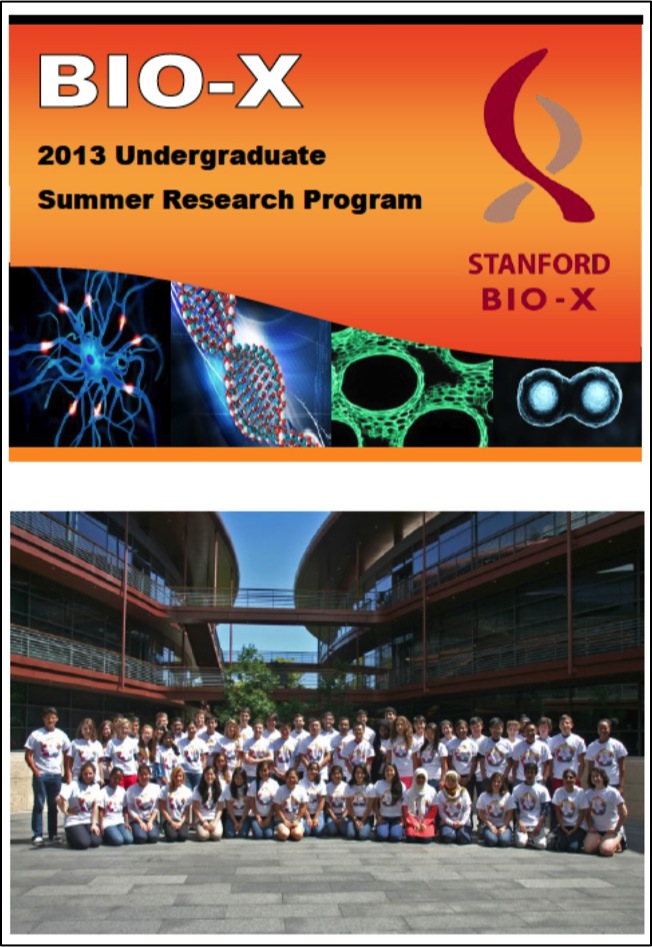 BIO-X UNDERGRADUATE SUMMER RESEARCH PROGRAM
BIO-X UNDERGRADUATE SUMMER RESEARCH PROGRAM
The Bio-X Undergraduate Summer Research Program supports undergraduate research training through an award designed to support interdisciplinary undergraduate summer research projects. The program is an invaluable opportunity for students to conduct hands-on research, learn how to carry out experiments in the laboratory, and develop the skills to read and analyze scientific literature. This program is eligible to Stanford students who want to work in the labs of Bio-X affiliated faculty.
To date, with 65 new awardees from 154 applications submitted this year, 306 students have been awarded the opportunity to participate in the Bio-X Undergraduate Summer Research Program.
Participating undergraduates are also required to present poster presentations on the research that they've conducted during the program. Please click here for title lists of past posters that our undergraduates have presented.
Many fruitful collaborations and relationships have been established with industry through fellowships. Please contact Dr. Hanwei Li or Dr. Heideh Fattaey if you'd like to learn more about how to get involved with these fellowship programs.
News
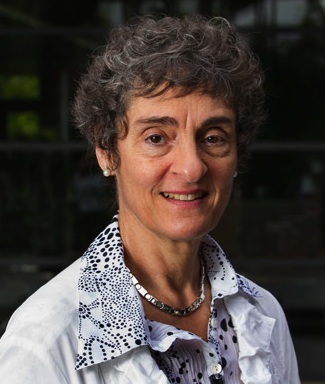 Decoy drug developed by Stanford Bio-X scientists allows brains of adult mice to form new connections
Decoy drug developed by Stanford Bio-X scientists allows brains of adult mice to form new connections
Bio-X Director Carla Shatz
At critical times in the brain's development, windows open when neurons can reach out and form new connections. The language window, for example, is open in time for kids to learn multiple languages and speak them like a native. Then it mostly closes, leaving adults fumbling for words and unable to roll their 'R's. The question has been what controls that window, and, more to the point, what can be done to prop it open later in life. Knowing that could do more than simply help older people with a travel bug. It could allow the brain to recover from stroke, some forms of blindness, Alzheimer's disease and other conditions that result from the loss of connections in the brain and an inability to form many new ones. Now a team of scientists at Stanford University has found that disabling the function of a single protein for as little as a week allows the brains of adult mice to form new connections, called synapses. "To me, this is amazing because what this is saying is that it is possible to induce new synapses in adult brains," said Carla Shatz, the David Starr Jordan Director of Stanford Bio-X, which supports interdisciplinary biomedical research. Shatz was senior author on a research paper describing this work, published Oct. 15 in Science Translational Medicine.

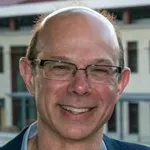
 Miniature wireless device being developed by Stanford Bio-X team creates better way of studying chronic pain
Miniature wireless device being developed by Stanford Bio-X team creates better way of studying chronic pain
Bio-X Affiliated Faculty Ada Poon, Scott Delp, and David Clark
Bio-X 2014 IIP Seed Grant Project
Bio-X Fellow Kathryn Montgomery
Ada Poon, a Stanford assistant professor of electrical engineering, is a master at building miniscule wireless devices that function in the body and can be powered remotely. Now, she and collaborators in bioengineering and anesthesia want to leverage this technology to develop a way of studying – and eventually developing treatments for – pain. Chronic pain costs the economy $600 billion a year and the two most common treatments have significant drawbacks: narcotics are addictive and surgery is costly and carries considerable risks. "Many people simply can't find a medication or technique to control their pain, despite all the approaches available," said David Clark, a professor of anesthesiology and pain management who treats patients with chronic pain in his medical practice. "Most people don't even achieve 50 percent pain control." The collaboration builds on work by Scott Delp, professor of bioengineering and mechanical engineering, and his students Kate Montgomery, who is a Bio-X fellow, and Shrivats Iyer. They developed a way of using light to control the activity of neurons that transmit pain, taking advantage of a technique called optogenetics. One color of light stopped the nerve from firing and prevented pain. Another color caused the nerve to fire.
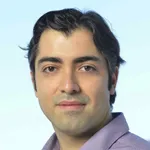
 Stanford engineers develop tiny, sound-powered chip to serve as medical device
Stanford engineers develop tiny, sound-powered chip to serve as medical device
Bio-X Affiliated Faculty Amin Arbabian and Butrus (Pierre) Khuri-Yakub
Medical researchers would like to plant tiny electronic devices deep inside our bodies to monitor biological processes and deliver pinpoint therapies to treat illness or relieve pain. But so far engineers have been unable to make such devices small and useful enough. Providing electric power to medical implants has been one stumbling block. Using wires or batteries to deliver power tends to make implants too big, too clumsy – or both. Now, Stanford engineers are developing a way to send power – safely and wirelessly – to "smart chips" programmed to perform medical tasks and report back the results. Their approach involves beaming ultrasound at a tiny device inside the body designed to do three things: convert the incoming sound waves into electricity; process and execute medical commands; and report the completed activity via a tiny built-in radio antenna. "We think this will enable researchers to develop a new generation of tiny implants designed for a wide array of medical applications," said Amin Arbabian, an assistant professor of electrical engineering at Stanford. Arbabian's team recently presented a working prototype of this wireless medical implant system at the IEEE Custom Integrated Circuits Conference in San Jose.
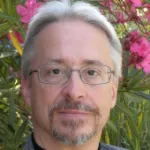 Drug may prevent development of invasive bladder cancer, researchers say
Drug may prevent development of invasive bladder cancer, researchers say
Bio-X Affiliated Faculty Philip Beachy
A drug already approved for use in humans may prevent invasive bladder cancer, according to a study by researchers at the Stanford University School of Medicine. The drug, FK506, is commonly used to suppress the immune system in organ transplant recipients to combat rejection. The researchers found that low doses of FK506, also known as tacrolimus, prevented the development of invasive bladder cancer in 10 out of 10 laboratory mice that were given a carcinogen over five months. In contrast, seven of nine control mice developed invasive cancers during the same time period. “This could be a boon to the management of bladder cancer patients,” said Philip Beachy, PhD, professor of biochemistry and of developmental biology at Stanford and a Howard Hughes Medical Institute investigator. “Bladder cancer is the most expensive cancer to treat per patient because most patients require continual monitoring. The effective prevention of progression to invasive carcinoma would be a major advance in the treatment of this disease.” Beachy is the Ernest and Amelia Gallo Professor in the School of Medicine and a member of the Stanford Cancer Institute and the Stanford Institute for Stem Cell Biology and Regenerative Medicine. He is the senior author of the study, published Oct. 13 in Cancer Cell. Former postdoctoral scholar Kunyoo Shin, PhD, and former graduate student Agnes Lim, PhD, are the lead authors.
Events
| Bio-X October 20, 2014, 12 pm - 1:05 pm Clark Center S361, Stanford, CA Bio-X Frontiers in Interdisciplinary Biosciences Pre-Seminar Speaker: William Greenleaf, PhD, Stanford University |
Biology Oct 20, 2014, 4 pm - 5:30 pm Clark Center Auditorium, Stanford, CA "New Protein Engineered Tools for Signaling" Speaker: Jim Wells, PhD, UCSF |
| Cardiovascular Institute October 21, 2014, 12 pm - 1 pm LKSC Rm 120, Stanford, CA Frontiers in Cardiovascular Science: "Ultrasound Molecular Imaging in Cardiovascular Medicine and Drug Development" Speaker: Jonathan R. Lindner, MD, OHSU |
Bio-X Oct 23, 2014, 12 pm - 1:05 pm Clark Center S360, Stanford, CA Bio-X Frontiers in Interdisciplinary Biosciences Seminar: "Regulation of the 3D Genome" Speaker: Bing Ren, PhD, UCSD |
| BIO-X SYMPOSIUM - MECHANOBIOLOGY: PUSHING AND PULLING ON LIFE Thursday, November 6, 2014 Clark Center Auditorium This Symposium aims to educate students, postdoctoral fellows and established scientists from different disciplines about Mechanobiology by presenting talks on sensory systems, mechanically mediated cellular signaling, and the role of mechanics in homeostasis. Topics include mechanisms, methods and mechanical pathways ranging in temporal and spatial scales from ion channels and protein conformational changes to cell and tissue mechanics in growth, differentiation, disease and regeneration. The Symposium features invited speakers, talks from postdoctoral fellows selected from submitted abstracts, a networking lunch, and poster reception. 9:00am Welcome and Introduction 9:15am Chemomechanical Markers and Modulators of Stem Cells: Pulling It All Together Krystyn Van Vliet, Massachusetts Institute of Technology 10:00am Chromosome Segregation: Mechanical Integrity with Dynamic Parts Sophie Dumont, University of California, San Francisco 10:45am Coffee Break 11:15am Postdoctoral Fellows Talks 12:30pm Lunch - Students may register in advance for lunch with faculty 1:45pm Touch As a Matter of Fat and Mechanics Miriam Goodman, Stanford University 2:30pm A Leaky Pipeline: Matrix Mechanics in Vascular Form and Function Cindy Reinhart-King, Cornell University 3:15pm Coffee Break 3:45pm Mechanical Regulation of Cell Adhesion and Migration Margaret Gardel, The University of Chicago 4:30pm-6:00pm Poster Session and Refreshments Symposium Organizers: Beth Pruitt (ME, MCP by courtesy, Bio-X) and W. James Nelson (Biology, MCP, Bio-X) To RSVP, please go here |
Resources
| Stanford University |
| Stanford Bio-X |
| Bio-X Seed Grants The Stanford Bio-X Interdisciplinary Initiatives Program (IIP) provides seed funding for high-risk, high-reward, collaborative projects across the university, and have been highly successful in fostering transformative research. |
| Office of Technology and Licensing "Techfinder" Search the OTL Technology Portal to find technologies available for licensing from Stanford. |
| Stanford Center for Professional Development - Take advantage of your FREE membership! - Take online graduate courses in engineering, leadership and management, bioscience, and more. - Register for free webinars and seminars, and gets discounts on courses. |
| Stanford Biodesign Video Tutorials on how FDA approves medical devices A series of video briefs recently produced by the Stanford Biodesign Program teaches innovators how to get a medical device approved for use in the United States. This free, online library of 60 videos provides detailed information on the Food and Drug Administration regulatory process, short case studies and advice on interacting with the FDA. |
To learn more about Stanford Bio-X or Stanford University, please contact Dr. Hanwei Li, the Bio-X Corporate Forum Liaison, at 650-725-1523 or lhanwei1@stanford.edu, or Dr. Heideh Fattaey, the Executive Director of Bio-X Operations and Programs, at 650-799-1608 or hfattaey@stanford.edu.


